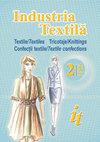Antimicrobial treatment for textiles based on flavonoid-mediated silver nanoparticles dispersions
IF 0.9
4区 工程技术
Q3 MATERIALS SCIENCE, TEXTILES
引用次数: 0
Abstract
The use of “green” reagents for silver nanoparticles (AgNPs) synthesis represents an attractive alternative to conventional methods, due to the abundance of available biomass with reducing properties. Herein, a flavonoid compound, hesperidin, was used to produce AgNPs, and the resulting dispersion was applied to textile fabrics and tested for its antimicrobial properties. Different ratios of flavonoid to the silver precursor (v:v) were prepared. The formation of the nanoparticles was indicated by the presence of the SPR specific band in the UV–Vis spectra. For the synthesis optimization, the DLS technique was used to determine the size and polydispersity of the AgNPs, while zeta potential measurements were performed to assess their physical stability. For the dispersion with the optimal ratio, particles with the average size (Zav ) of 93.55±3.51 nm were obtained, with a polydispersity index (PdI) of 0.259. For this ratio, the value of the zeta potential (ξ.) was –28.80±1.54 mV, indicating that the dispersion is physically stable. The nanoparticles were further characterized using SEM-EDS techniques to confirm the particles' nature and evaluate their morphology. The AgNPs were deposited on textile samples, by direct soaking into the dispersion. The distribution of the AgNPs on the textile samples fibres was evaluated by SEM and the chromatic parameters L*a*b* were determined compared to the untreated samples. Antimicrobial tests were conducted against Escherichia coli, Staphylococcus aureus, and Bacillus subtilis strains, according to the ISO 20743:2013 standard, and percentages of bacterial reduction up to 99.99% were obtained.基于类黄酮介导的银纳米粒子分散体的纺织品抗菌处理
使用“绿色”试剂合成银纳米颗粒(AgNPs)是传统方法的一种有吸引力的替代方法,因为有大量具有还原性能的可用生物质。本文使用黄酮类化合物橙皮苷生产AgNPs,并将所得分散体应用于纺织织物上,测试其抗菌性能。制备了不同比例的类黄酮与银前体(v:v)。紫外-可见光谱中SPR特异性带的存在表明了纳米颗粒的形成。对于合成优化,DLS技术用于确定AgNP的大小和多分散性,同时进行ζ电位测量以评估其物理稳定性。对于具有最佳比例的分散体,获得了平均尺寸(Zav)为93.55±3.51nm的颗粒,多分散指数(PdI)为0.259。对于该比率,ζ电位(ξ.)的值为–28.80±1.54 mV,表明分散体在物理上是稳定的。使用SEM-EDS技术对纳米颗粒进行了进一步表征,以确认颗粒的性质并评估其形态。通过直接浸泡在分散体中,将AgNPs沉积在纺织品样品上。通过SEM评估了AgNPs在纺织品样品纤维上的分布,并与未处理的样品进行了比较,确定了L*a*b*的颜色参数。根据ISO 20743:2013标准,对大肠杆菌、葡萄球菌和枯草芽孢杆菌菌株进行了抗菌试验,获得了高达99.99%的细菌还原率。
本文章由计算机程序翻译,如有差异,请以英文原文为准。
求助全文
约1分钟内获得全文
求助全文
来源期刊

Industria Textila
工程技术-材料科学:纺织
CiteScore
1.80
自引率
14.30%
发文量
81
审稿时长
3.5 months
期刊介绍:
Industria Textila journal is addressed to university and research specialists, to companies active in the textiles and clothing sector and to the related sectors users of textile products with a technical purpose.
 求助内容:
求助内容: 应助结果提醒方式:
应助结果提醒方式:


